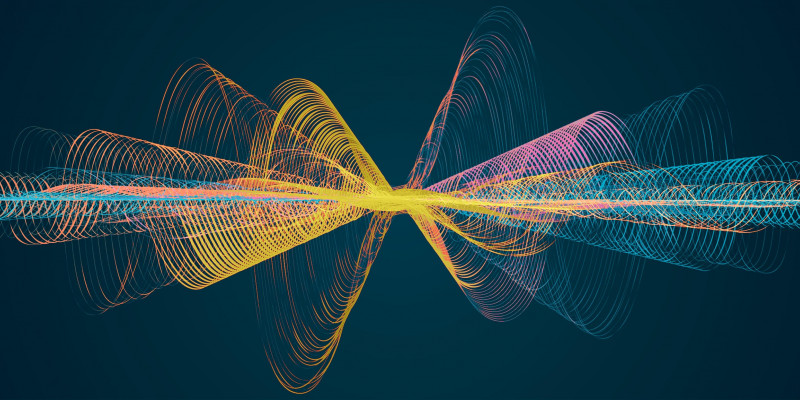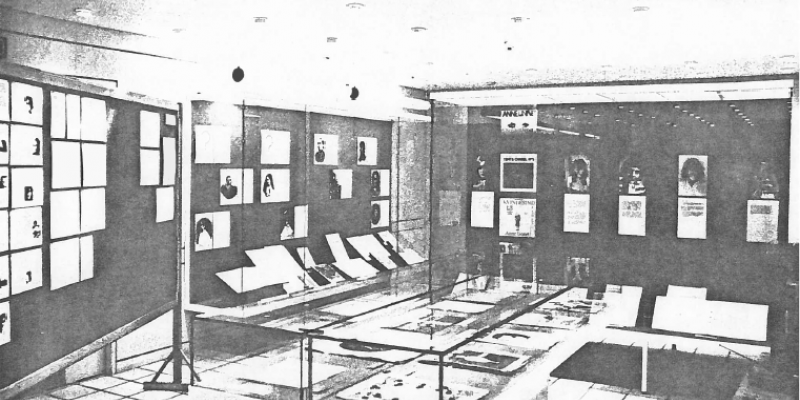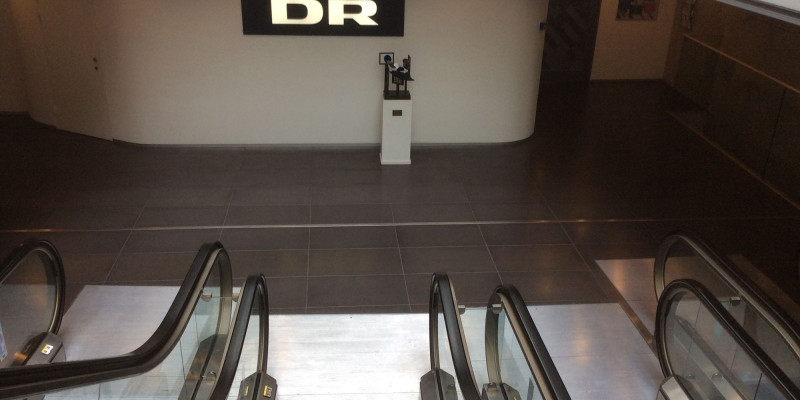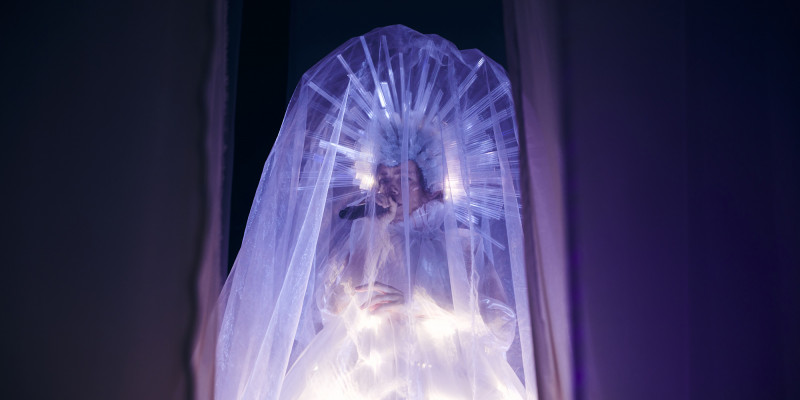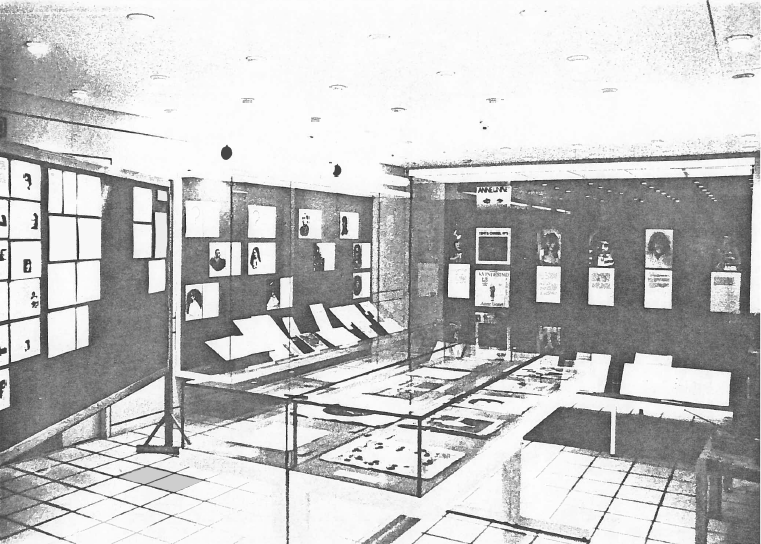
Exhibiting the unheard(-of)
Abstract
How come women composers are still so inadequately represented in historical canons and museum exhibitions? With a focus on historical Danish women composers and from the perspective of the Danish Music Museum, I argue that this is largely due to memory culture, an incredibly powerful frame within the realms of classical music and curatorial practices. This is illustrated, first, by discussing an exhibition at The Musikhistorisk Museum & The Carl Claudius Collection, Kvinder komponerer [Women Compose] from 1980 and its (limited but notable) legacy 40 years later. Second, I triangulate between memory studies, gender studies, and historical musicology in order to discuss memory culture as an overlooked but all-important obstacle in the rediscovery of women composers. Third, I argue that mechanisms within memory culture could be better utilized positively as a tool for reviving women composers and imbuing their oeuvres with increased cultural meaning. I suggest this can be done by (1) granting musical works from women composers the attention they deserve (thus going beyond the anxiety towards the ‘work’ and work-analysis that accompanied the advent of feminist musicology), and (2) narrating women composers into broader cultural memories connected to, for instance, the Danish Women’s Right movement (thus going beyond biography).
Introduction
I will set off this article on a personal note: In November 2020, in the midst of that horrid Covid-cloud that seemed to be slowly choking the culture industry, I had an on-stage conversation at The Danish Music Museum with the female musical collective Damkapellet about their work with music by women composers.1 The talk was part of Klang Festival 2020, and for pandemic reasons, the crowd was not too large (I was lucky that the nearly 20-person Damkapellet provided an ‘automatic’ audience!). I was eager to discuss difficult questions about representation, tacit but persistent ideas about gender and creativity, the danger of perpetuating the woman composer as ‘the Other,’ and more. But I was also struck by how much I simultaneously longed for the living and breathing cultural life that I already knew well. How I would have loved to celebrate Beethoven’s 250th birthday in the way that the world had probably envisioned before the pandemic put a stop to it! Anything other than this virus and the silence of the concert halls, I thought. Hence, it felt strange, to my surprise, to talk about change and critique of the canon, when the canon actually represented, to me at least, a desirable pre-viral state of all-is-well.
Perhaps that was why some of my questions came out tangled and academic. A lot of our conversation came to circle around historical women composers even though Klang Festival focuses on contemporary art music. While on stage, I thus became worried that what I had prepared was wholly unsuccessful. At least until I heard the response from the small audience: Apart from a series of good questions I wish I had asked myself, a young woman composer (who shall remain unnamed for the present purposes) shared her experiences. She expressed how tiresome and lonely it was to be a woman composer in Denmark, to the point where she often thought about quitting completely. She felt constantly out of place, having few or no role models or histories to reflect her experiences in. But hearing about historical women composers at today’s conversation, she said, had been an eye-opener.
Her testimony made a deep impression on me: my own longing for the well-known suddenly appeared not as ephemeral corona-escapism, but as the chief obstacle for the historical and contemporary woman composer, pandemic or not. If one can make it as far as she had and still consider quitting, chiefly because of one’s gender, and if historical women composers remain unknown even to present women composers in need of historical representation, then we do have a serious problem. Her response turned into firm conviction what had until then been loose assumption: The battle for improving gender-equality in music today begins in the past.
As a researcher at The Danish Music Museum working on a project about historical women composers – a category that seems to remain largely unheard (in the sense: not listened to) and unheard-of (in the sense: unfamiliar or even provoking) – I have of course pondered the possibilities of curating an exhibition on Danish women composers. This article is a discussion of some of the curatorial challenges that immediately present themselves in such a project. While this article can make no promise of an actual exhibition on women composers in the near future – so much depends, unfortunately, on the economic aftermath of the Covid-19 pandemic – the article is meant to discuss questions that are pertinent in any musicological research with a critical eye to the canon. The curatorial challenges that immediately present themselves function as a photographic developer, making visible the infrastructure that the (researcher on the) historical woman composer must navigate in.
The article sets out by describing and reflecting on an earlier exhibition on women composers at The Danish Music Museum, namely Kvinder komponerer [Women Compose] from 1980. The case illustrates that a successful exhibition of the forgotten part of Danish music history that women composers represent is possible, but also difficult: 40 years later, we may well ask what difference this exhibition made. After a discussion of this question, I discuss whether a special exhibition such as Kvinder komponerer to a certain extend involuntarily contributes to the continued ‘othering’ of historical women composers, in that it fails to instill them into broader cultural memory. I then dive into the concept of cultural memory and discuss how it functions as a dominant ‘infrastructure’ in classical music and curatorial practice, an infrastructure that is not immediately accessible in the case of historical women composers who often belong to cultural oblivion. In the last part of the article, I argue that this fundamental curatorial challenge must be faced, and that an eventual new exhibition – and other musicological engagements with women composers – must go beyond the strictly biographical model and instead strive to benefit from mechanisms within memory culture by 1) rendering possible that musical works from women composers achieve an ‘aesthetic presence’ as Carl Dahlhaus (1983, p. 7) has called it, and 2) narrating women composers into broader cultural memories surrounding (for instance) the Danish Women’s Rights Movement. In short, the main point is that the infrastructure of memory culture represents not just an obstacle, but also a constructive tool which must be better utilized in telling the story of how women have been composing and musicking throughout history – and how today’s female musicians, composers, and sound-artists do have a history to rediscover, reflect in, and remember.
A Case from the Past: Kvinder komponerer, 1980
Musicology’s interest in forgotten women composers and other questions regarding music, gender, and sexuality first seriously began to grow in the 1980s. Watershed publications from this era include the International Encyclopedia of Women Composers by Aaron I. Cohen (1981) – its listing of more than 5000 names was a feat in itself – Women Making Music, edited by Jane Bowers and Judith Tick (1987), Feminine Endings by Susan McClary (1991), Gender and the Musical Canon by Marcia J. Citron (1993), and the eight-volume Women Composers: Music Through the Ages, edited by Martha Furman Schleifer and Sylvia Glickman (1996–2006). As such, The Danish Music Museum – which at the time held the name Musikhistorisk Museum & The Carl Claudius Collection (Musikhistorisk Museum & Carl Claudius’ Samling) – was admirably much ‘on the beat’ when they curated the special exhibition Kvinder komponerer (Women Compose) in 1980.2 The exhibition itself focused mostly on 21 women composers (mentioned shortly), while the exhibition catalogue presented, among other things, a list of 339 Danish women composers. As Ole Kongsted wrote:
A number which may seem large or small depending on one’s perspective - - large, probably, to that gentleman who, upon hearing about the museum’s plans on this exhibition, asked: »Well – I take it you will exhibit both of them?« - - smaller, probably, when taking into consideration that there is in fact 7–8 generations between the oldest and the youngest composers.3 (Kongsted 1980, p. I; my translation)
The exhibition was a collective effort by employees of the museum with Ole Kongsted, who was curator at the museum at the time, as primum mobile on the exhibition and the research revolving around it. Concretely, the exhibition consisted of three showcases, a bulletin board, and two listening stations, as shown in Example 1 and Example 2. Showcase 1 (‘Montre 1’) focused on historical women composers and contained a series of short wall texts, photographs (where available) and artefacts such as musical scores (manuscripts or published versions). The composers in focus here were countess Maria Theresia Ahlefeldt (1755–1823), Emma Hartmann (1807–1851), Johanne Luise Heiberg (1812–1890), Henriette Nielsen (1815–1900), Nanny Melbye (1830–1915), Caroline Recke-Madsen (1833–1901), Johanne Fenger (1836–1913), Nanna Liebmann (1849–1935), Hilda Sehested (1858–1936), Tekla Griebel Wandall (1866–1940), and Nancy Dalberg (1881–1949). A photo of this showcase is seen in Example 3, while Example 4 shows a more detailed view of the showcase’s right end.
Showcase 2 contained similar material from composers alive at the time of the exhibition: Beate Novi (1883–1981), Benna Moe (1897–1983), Else Marie Pade (1924–2016), Gudrun Lund (1930–2020), Diana Pereira (1932–), Vivian Dahl (1938–), Birgitte Alsted (1942–), Helle Norup (1947–2020), Hanne Rømer (1949–), and Anne Linnet (1953–).
Showcase 3 contained artefacts such as the program of the Women’s Exhibition (Kvindernes Udstilling) in Copenhagen, 1895, the collection of songs published in that connection (Hammerich, 1895), and even more excerpts from scores by other composers. Unfortunately, the exact contents of the bulletin board do not appear from the archived material from the exhibition, but judging from its appearance on the left side of Example 2, it seems to contain more pictures and wall text – likely the short biographical sketches of different composers that was also published in the exhibition catalogue (Kongsted, 1980).
The museum exhibited sounding music as well. At the two listening stations (‘lytteposter’) shown in Example 1, the audience could wear headphones and listen to excerpts from 11 different works recorded on cassette tape. The works are listed in Example 5. Notably, the works are all from contemporary composers alive at the time of the exhibition, bearing witness to the fact that recordings of music by historical composers were simply not available. Fast forward some 40 years, and the situation has not improved much.4
![Example 1: Overview of the exhibition Kvinder komponerer, 1980 (The Danish Music Museum, MMCCS archive 166). [Indgang = entrance; montre = showcase; opslagstavle = bulletin board; lytteposter = listening stations]](/sites/default/files/styles/w864px/public/images/Example%201%20-%20exhibition%20overview.png?itok=Ho5XjJgp)
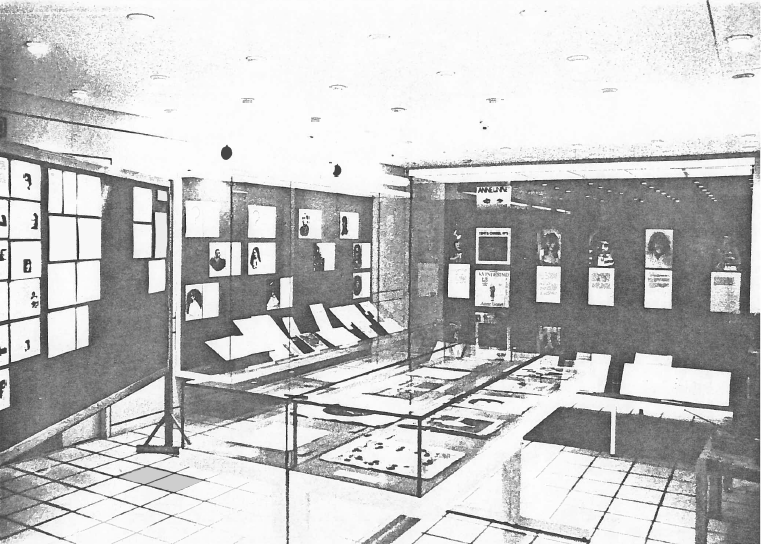

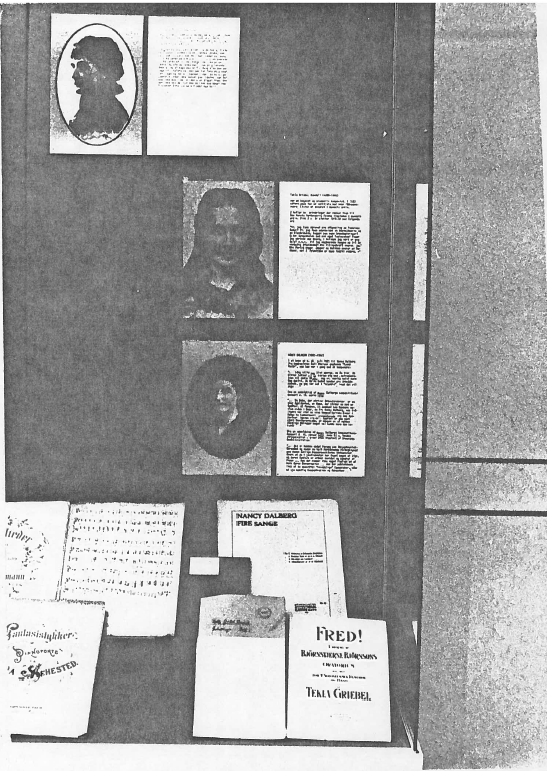
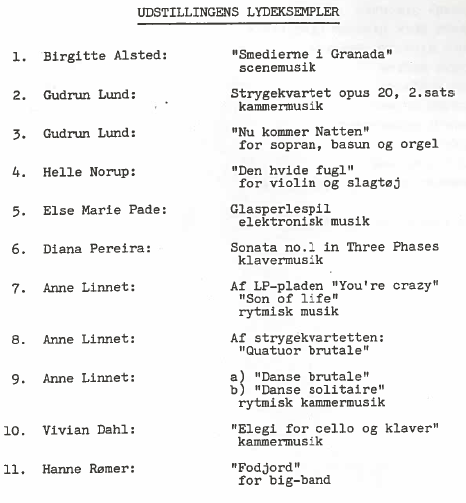
While the exhibition itself thus seems to have been focused very much on names and works – and on establishing the mere fact that women composers do exist – the opening of the exhibition, July 15 1980 at 1–4 pm, contained a panel debate which dug deeper into the problematics surrounding music and gender. This panel debate led to the establishment of the still active organization Kvinder i Musik [Women in Music].5 This is worth highlighting: Undoubtedly, providing the space and opportunity for the foundation of this prolific organization became the most influential aspect of the Kvinder komponerer exhibition. Since its foundation, Kvinder i Musik has been actively promoting historical and contemporary women composers’ work, and with the hundreds of concerts they have arranged and the numerous newsletters and yearbooks they have published, they provided what was for a long time the only Danish channel for disseminating knowledge about women composers.6
The panel consisted of composers Birgitte Alsted, Gudrun Lund, Else Marie Pade and Diana Pereira, and it was initiated with a talk by Anne Kirstine Nielsen, who had been involved in the creation of the exhibition. The latter’s talk was also published ahead of the event in the newspaper Politiken (11 July 1980) and in Dansk Musik Tidsskrift (Nielsen, 1980–81). The talk voiced concerns that could just as well be voiced today. To the often-heard interjection7 that women composers must have been forgotten simply because their music is not good enough, Nielsen responds: »For what and for whom is the music too bad?: For the male-dominated musical life and the male musical tradition, that is, the musical tradition. In spite of women’s liberation and equality, we still drag around the heavy burdens acquired under the territorial advancements of the white man«8 (Nielsen, 1980–81, p. 50; my translation).
The exhibition was a success. The music department of the public library in Odense even contacted the museum and asked to host the exhibition once it had run its course in Copenhagen, and thus, it was set up again in March 2–March 28, 1981, at Odense Musikbibliotek. This was accompanied by an event with Birgitte Alsted, who discussed her experiences as a woman composer in Denmark and recited some of her compositions (5 March 1981), as well as a concert with Hanne Rømer (saxophone) and Marietta Wandall (piano) (24 March 1981). According to a press release from Odense Musikbibliotek, the exhibition was even meant to travel to both New York and Munich.9 This cannot be confirmed by correspondences saved in the museum’s archive, but it can be confirmed that the museum translated and shipped material from the exhibition to a similar exhibition in Vienna, Komponierende Damen aus den letzten 600 Jahren arranged by the Bundesministerium für Unterricht in Austria through the Danish Embassy in Vienna, and that there were also tentative plans for an exhibition in Iceland.10
40 Years Later: Status Quo?
What is striking today is that the exhibition – and the impressively vast amount of research that the exhibition and the catalogue (Kongsted, 1980) represented – seems to have had little lasting impact on Danish music historiography or on women composers’ possibilities. This is not to say that it was without impact: Undoubtedly, the foundation of Kvinder i Musik in the wake of the exhibition’s panel debate was significant. Also mentioned above, there is no doubt that research in women composers has flourished internationally since the 1980s. In Denmark, much of that research was, for a long time, available only in unpublished and hard-to-acquire Master’s thesises.11 An example is Musse Magnussen Svare’s excellent Master’s thesis which still represents the only substantial source about the Danish composer Maria Theresia Ahlefeldt (1755–1800), and which originated as a reaction against certain formulations in Ole Kongsted’s exhibition catalogue (Magnussen, 1990, pp. 10–14). Subsequently, women composers found their way into encyclopedia such as Den Store Danske and Dansk Kvindebiografisk Leksikon. Finally, in 2007, the first book-length study on Danish women composers was published by Lisbeth Ahlgren Jensen (Det kvindelige spillerum), but for a long time, this feat stood alone in the Danish musicological landscape. More recent years, however, have seen a surge of interest in women composers, not just within academia, but also in the public.12 Three recent composer biographies solidify this tendency (Jensen, 2019; Marstal, 2019; Kirkegaard, 2022). At the same time, much indicates that even if the situation is improving, it is still not substantially better. To a large extent, research on women composers remain a niche field which is still to find its way out of the encyclopedia and singular biographies (important and valuable though they are) and into broader textbooks and music histories.
When it comes to performances of music by women composers, the advancements in research are hardly discernible: Repertoire statistics published in 2018 and 2021 document that music by women – and especially by historical women – make up a very small part of classical music performed in Denmark (Hannibal and Jacobsen, 2018; Hastrup and Hannibal, 2018; Jensen and Hannibal, 2021). There is a small improvement from 2018 to 2021, but even so, the statistics from 2021 show that music written by women after 1988 make up 21,1% of performed music; and music by historical women make up a stunning 0,5%. Recordings of music by historical (especially Danish) women composers are still lacking (as discussed in footnote 4).
The effect of any single exhibition (temporal events as they are) or another contribution will always be limited, of course, but still, the case is telling: Women composers remain, by and large, an ‘othered’ category, almost completely absent in Danish music historiography, with the possible exception of a few names such as Else Marie Pade and Birgitte Alsted.
Feminist musicology has often reflected on the danger that it may unwillingly preserve the woman composer as an othered and ‘essentialized’ category exactly by viewing it as a category that merits a special focus. Marcia J. Citron discussed the danger of »ascribing to women innate characteristics and thereby diminishing the importance of social context and individual difference« in her Gender and the Musical Canon (1993, p. 7); and Susan Wollenberg’s keynote address at the 2020 conference Women are not born to compose entitled ‘(Why) Do We Need ‘Women Composers’?’ was an extended argument as to why women composers are »a unique case in the historiography of Western art music« 13 worthy of special treatment, despite the continued worry that special treatment also comes with a downside. The exhibition Kvinder komponerer illustrates the dilemma well. The fact that there was a need for a special exhibition on women composers in 1980 spoke volumes about contemporary ideas on gender and musical creativity. The category of the ‘woman composer’ was unknown enough to merit a special focus, exotic enough to attract audiences, strange enough to justify a narration of a history unconnected to the ‘male composer’ – a category which is tellingly never put on the table. But even though we are lucky to have several well-known contemporary woman composers today, the category of the historical or historically important woman composer is arguably as unfamiliar today as it was in 1980. More than 40 years after that exhibition, the woman composer remains marked, tainted, unheard-of.
Is a special exhibition such as Kvinder komponerer simply yet another way of marking the woman composer? On the one hand, it is obvious that we still know too little about historical women composers, and any special focus on them fills a void in our knowledge. It is also obvious that gender and received notions about gender-roles have played important roles in forming the opportunities for and reception of composers, which clearly justifies a gender-oriented focus. On the other hand, the ‘endgame’ would, for many, be an arrival at a situation in which the woman composer was normalized to the extent that we can start speaking of the composer without necessarily referring to her gender – or, perhaps more interesting, to start going beyond the binary gender-conception that runs as a stream beneath much of the research I refer to here. But how does one arrive at such an integration – rather than separation – of the woman composer into music history? How does one do this without succumbing to an ‘add-and-stir’ strategy14 or a two-dimensional tokenism making little difference in the existing historical framework? This entire dilemma has been widely discussed, not only in feminist musicology, but also in other fields focused on oppressed or ‘subaltern’ groups. As a way of approaching this dilemma, Gayatri Spivak coined the useful term ‘strategic essentialism’ (1996, pp. 204–5, 214), which can be briefly described as a »political strategy whereby differences (within a group) are temporarily downplayed and unity assumed for the sake of achieving political goals« (Eide, 2016, p. 2).
With this in mind, the problem is not the special exhibition itself, nor the special issue of the academic journal, nor the use of the locution ‘woman composer’ in other contexts. No, the problem is that historical women composers belong, still, to cultural oblivion15 : For many, even within academia and conservatories, they remain a special subject, something obscure and unknown, disconnected from the rest of music history. This entails a fundamental challenge which greatly impedes the dissemination of knowledge about women composers. Pointing to that which has long belonged to oblivion can be like pointing to a blind spot – one may become aware of its presence, but that does not mean that one can really see it. It requires, in other words, a lot of work to make the woman composer make sense, mainly because – so I will argue – she largely stands outside of our cultural memory. To explain this point in further detail, I turn now to the concepts of cultural memory and memory culture.
Cultural Memory and Memory Culture
It is a truism that history is our telling of the past; it is not an accumulation of facts about everything that happened in the past. Thus, any history involves processes of inclusion and exclusion: what, who, and where gets to be retold as ‘belonging to history’? That women have generally been excluded from music history and the canon is beyond doubt. It is certainly relevant and even necessary to criticize this historiographical neglect, but a perspective that is too often lacking in such critiques is a look to the function and use of the established history and the musical canon, which surely goes beyond the act of excluding certain identities from history.16 Interesting and useful perspectives on the function and use of history have been offered in the formidably large research field of memory studies, but a line between insights in memory studies and gender studies, respectively, is still to be drawn – at least within musicology (but see Paletschek and Schraut, 2008a; 2008b; Dubriwny and Poirot, 2017; Bierlich, 2019). In the following, therefore, I will point to a series of important insights in memory studies, especially as they pertain to classical music; I will then discuss the museological practice of appealing to cultural memory as a means of communication and user engagement, for example by using nostalgia as an affective strategy; and finally, I will point out the substantial difficulties of using such strategies and practices in the telling of the history of women composers, many of whom belong to cultural oblivion rather than cultural memory.
In a general perspective, memory studies recast the past as something not just written in books as ‘history’, but as something having a real presence in people’s lives in the form of commemorative practices and collective memories. Maurice Halbwachs (1877–1945) coined the term ‘collective memory’ based on the foundational idea that memory is social in its essence: it is not just the individual herself who decides what to remember and what to forget; these processes are always influenced by the collective and its interests (Halbwachs, 1992). Jan Assmann has, more recently, discussed different types of collective memory (Assmann, 1995). One type is what he calls communicative memory which is based on everyday oral transfers of individuals’ actual memories; thus, communicative memories typically extend back no more than 80–100 years at most. Another type, the one that will engage us here, is cultural memory (notice that in this view, cultural memory is a subterm under collective memory, though the two are sometimes seen used interchangeably). Cultural memories are those memories that are given formal presence even after their existence as communicative memories may have been terminated; they are »maintained through cultural formation (texts, rites, monuments) and institutional communication (recitation, practice, observance)« (Assmann, 1995, p. 129). They exist through practices of commemoration; they are often embraced by institutions as ‘heritage’; and they are formed by and form group-identity by preserving »the store of knowledge from which a group derives an awareness of its unity and peculiarity« (ibid., p. 130). In their anchoring in objects, practices, and institutions, their mode of existence is thus distinguished from that of the individual’s memory as well as history writ large. Significantly, they may, with Pierre Nora’s words, exist as lieux de mémoires, or sites of memory (Nora, 1989, p. 7 et passim).
Les lieux de mémoire was the title and focal point of a seven-volume book project published 1984–1992 edited by Nora17 ; a good (and shorter) introduction to the concept is the text ‘Between Memory and History: Les Lieux de Mémoire’ (Nora, 1989). The concept became incredibly influential in memory studies, but also within more interdisciplinary areas drawing on memory studies – and like any such very influential term, it has also been interpreted in a variety of ways. In my understanding, Nora’s project was – first – to point out a general development in the way we18 perceive the past. In the pre-industrial society, there was a relation of identity between memory and history: »We have seen the end of societies that had long assured the transmission and conservation of collectively remembered values, whether through churches or schools, the family or the state« (ibid., p. 7). In the modern, industrial society there is, on the other hand, a relation of polarization between memory and history; we are confronted »with the brutal realization of the difference between real memory […] and history, which is how our hopelessly forgetful modern societies, propelled by change, organize the past« (ibid., p. 8). Nora defines memory as living, affective, magic, selective, bound to groups and concrete objects, while history is a reconstruction, it is intellectual, analytical, critical, and concerned with abstract developments and relations in a temporal lens (ibid., pp. 8–9).19 His project was then – second – to investigate in detail the lieu de mémoire as the ‘surrogate’ for the real milieu de mémoire that existed before memory and history were separated: »Lieux de mémoire originate with the sense that there is no spontaneous memory, that we must deliberately create archives, maintain anniversaries, organize celebrations, pronounce eulogies, and notarize bills because such activities no longer occur naturally« (ibid., p. 12).
What is important to understand is that the lieux de mémoire is an inclusive and also somewhat elusive concept. The ‘site of memory’ need not be an actual site or place – though it can be – it can also be a ritual or an object. When Nora uses the words ‘affective’ and ‘magical’, he points to that feeling which may occur, as described above, when one is confronted with objects or participating in rituals that seem to draw a direct and living connection between the past and the present – this is something quite different than mere history and historiography, dry and academic as they are.
Understandably, the concept of lieux de mémoire also found its way into music studies, perhaps because it seems blatantly obvious that music (and other art forms) may simultaneously act as a historical document of the past and a living artwork of the present, and, thus, that it is readily capable of conveying that sense of profound connection and identification with (people of) the past. Even Carl Dahlhaus, whose historiographical writings predate Nora’s concept, cannot help but evoke the idea of the musical work as a lieu de mémoire when he speaks of the ‘aesthetic presence’ (Dahlhaus, 1983, p. 7) of the work – its dual existence as document of the past and artwork of the present. The idea of ‘aesthetic presence’ is one to which I will return.
A great example of how music, and especially canonic classical music, may function as lieux de mémoire is provided in Vanessa Williams’ article ‘Welded in a single mass: Memory and Community in London’s Concert Halls during the First World War’ (2014). The article investigates the peculiar fact that during the First World War, British civilians steadily attended classical concerts with the canonic German repertoire on the program even though Germany was the enemy and other areas of contemporary art life banned anything German. The choice to continue performing music by Germans was not uncontested, of course, but sparked a broiling debate about composers and nationality, challenging the idea of musical universalism. Paradoxical as it may seem, some people argued that composers such as Bach and Beethoven inspired greater patriotism for the Allied than British battle hymns did – while, unsurprisingly, they were simultaneously used to inspire patriotism for German soldiers (Williams, 2014, p. 31). Williams points to Scott Burnham’s (1995) and Daniel Chua’s (2009) writings on Beethoven as a heroic figure, and remarks that »the fact that the same music can represent patriotic heroism for two supposedly opposed political aspirations is telling« (Williams, 2014, p. 32). But what was also at play in this continuance of the German canon, argues Williams, was a »desire for escapism«, and an attempt to »retreat to […] pre-War memories« (ibid., p. 34). Classical music became a safe haven from the war, concert-attending an act of evoking and bringing to life memories of the world of yesterday.20 As Williams notes herself, »Pierre Nora’s concept of lieux de mémoire is key to this reading« in that the classical concert itself became a site of cultural memory (ibid., p. 35).
Indeed, it is easy to conceive of the entire ritual of attending a classical concert – described in detail in Christopher Small’s Musicking (1998) – as a lieu de mémoire. But, as Small’s very reframing of music as ‘musicking’ indicates, ritualistic and commemorative practices may be pertinent in all realms of musical life, not only the classical. Processes of authorization of popular music as ‘heritage’ have been studied, for example, by Les Roberts and Sara Cohen (2014) who point to museums as one of several types of ‘authorizing’ institutions. Furthermore, museums may, and often do, actively engage in memory culture, making use of an object’s quality as a site of memory in curatorial and communicative practices. Such a strategy is discussed, for example, in an article by Christian Hviid Mortensen and Jacob Westergaard Madsen (Mortensen and Madsen, 2015). Referring to the above-mentioned tendency to frame popular and rock music as heritage, the authors, both involved in the (at the time upcoming) Museum for Pop, Rock and Youth Culture, Ragnarock, in Roskilde (Denmark), discuss how nostalgia may be used as an affective strategy in popular music exhibitions.21 Mortensen and Madsen refer to Fred Davis’ (1979) concept of reflexive nostalgia, which can be summarized as Charlotte Rørdam does it:
The reflexive nostalgia is conscious of its own dialogic plane. One understands that nostalgia is an exchange of past and present, in that the present is illuminated by the past, which means that the two levels are in a sort of palimpsestic interplay with one another.22 (Rørdam, 2012, p. 67; my translation)
In his book, Davis explores the strange fact that people are able to experience a sense of nostalgia, even for things and periods they have not experienced themselves, thus leaving hope that reflexive nostalgia may indeed be successfully utilized as a curatorial strategy, also when it comes to exhibiting the unknown. At the same time, it seems obvious that the strategy described by Mortensen and Madsen (2015) would be far more difficult to employ successfully in an exhibition on composers still largely unknown to the broader public. Somewhat tautologically, nostalgia works best as an affective strategy in museums if the objects in the exhibition are easily able to evoke nostalgia – that is, if they are likely to be received by the audience as more than mere remnants of the past. They need to ‘tap into’ an already existing ‘infrastructure’ of cultural memory and thus to present themselves as physical manifestations of memories, as lieux de mémoire.
Remembering Works and Working Memory
Now, turning back the attention to women composers, we see clearly the challenge that they pose for the concert hall or the museum as sites of cultural memory – or, conversely, the challenge that our dominant cultural memory poses for the women composers and their reception. Because women composers have generally not been incorporated in the canon, because they are generally left out of written music history, because they are generally not associated with (what is narrated as) important historical events, and because many of them are known only by name – if at all – we generally do not experience them or their music as representing a shared cultural memory or as evoking feelings of nostalgia. A performance of a piano piece by Hilda Sehested stands, if it is otherwise unmediated, completely context-less. We may enjoy the piece, but it is hardly a lieu de mémoire, for even if we recognize a certain romantic flavor in the harmonic language, we do not (yet)23 know the music-historical context it connects with. A manuscript page from Nancy Dalberg is not (yet) ‘laden’ with history and cultural memory in the same way that a manuscript page from Johannes Brahms or even a lesser-known composer such as Carl Reinecke is. A drawing by Tekla Griebel Wandall24 does not (yet) hold the same nostalgic-affective quality that a painting by Arnold Schoenberg does. What is more, it is seldom possible at all – or at least very resource-demanding – to use sounding music (an important aspect of Mortensen and Madsen’s [2015] suggestions) by women composers, because so much of the music from Danish women composers remains unrecorded and unpublished.
One may say this about many of the more-or-less forgotten male composers as well, of course. Extra work is required in order to put Ludolf Nielsen, Asger Juul, or Fini Henriques into their proper contexts compared with Niels W. Gade or Carl Nielsen (to stay within the realms of Danish music history). But the women composers share a destiny that the male composers do not: their music is not just unrecorded and unheard; they themselves, the historical ‘woman composer’ as such, remain, for many, unheard-of.
Pierre Nora’s concept of lieux de mémoire has been criticized as being gendered in itself (see Paletchek and Schraut, 2008b, p. 268 et passim). But rather than dismissing the concept as useless, I think it should be noted that the concept points to something very real in our memory culture: memory culture – not the concept itself, but its practices and places – is gendered to a large extent. Any gender-oriented challenge to prevailing canons and histories will have to face and overcome the obstacle of collective and cultural memory. Even if it is true that commemorative sites too often embody the memory of »a white heterosexual cisgendered male, reaffirming the ‘great man’ perspective« (Dubriwny and Poirot, 2017, p. 199), and too seldom challenge this perspective, it remains a communicative and curatorial obstacle that objects from the hand of an unknown woman composer do not instill themselves easily as ‘laden’ lieux de mémoire. Destabilizing the very memory culture and its canons themselves may be an interesting project with promising perspectives, but if it also entails an estrangement from existing cultural memories – the living, affective, nostalgic, embodied and in many ways ‘positive’ connection with the past – then it is more problematic. Although one might answer that such estrangement is already experienced by many marginalized groups, and that time is ripe for it to seep out to other groups, this circumstance nonetheless represents an unavoidable obstacle for the dissemination about knowledge of women composers.
Arguing that forgetting is automatic and necessary in a society, while remembering is the exception that demands an effort, Aleida Assmann has provided a useful distinction between active and passive cultural memory:25 »The institutions of active memory preserve the past as present while the institutions of passive memory preserve the past as past« (Assmann, 2008, p. 98). Active memory corresponds to the canon, that which is exhibited at the museum and actively circulated in a society. Passive memory corresponds to the archive, that which is »situated halfway between the canon and forgetting« (ibid., p. 102). Importantly, it is »stored and potentially available, but it is not interpreted« (ibid., p. 103).
I believe the word ‘interpreted’ is important here: as indicated by the case from the past, becoming part of a special exhibition does not automatically turn the exhibited into active cultural memory, even though institutional validation is certainly a step (as per Roberts and Cohen, 2014). What is needed for the remembrance of women composers to go beyond the occasional pop-up special exhibition (literal and figurative) is a deeper interpretation of their lives and their music – not just musicological work, but also what Annette Kuhn has termed memory work across a range of platforms and media (Kuhn, 2010). In accordance with general tendencies in memory studies, Kuhn reminds us that memory is performed, and that it is in this very performance, a continued process, that the past can come to represent not just cold history, but living memory as well. In other words, the memory culture which stands in the way of the woman composer, must be used productively. The composer must, individually and collectively, be understood in relation to larger narratives, narratives that extend far beyond the picture-and-name model. So, if the preceding paragraphs have given the impression that cultural memory cannot contain the woman composer and her music, I must stress that my point is exactly the opposite: It can and should, but it requires active memory work.
I would like to suggest two parameters that would have to be engaged for such memory work to have an effect. My suggestions are not necessarily sufficient, they do not at all represent ‘the only way’, but based on the discussions in this article, I believe a heightened attention to these parameters is worthwhile. One parameter is work-oriented, the other is context-oriented. The orientation towards context is very much in line with dominant research in the field of feminist musicology while an orientation towards the work is, if not controversial, then at least very infrequently discussed. But it must be remembered that one of the reasons that established music history – the active canon – is not just ‘cold’ but also ‘living’ is that canonical works have been granted what Dahlhaus (1983, p. 7) called an ‘aesthetic presence’, as mentioned above. Thus, a successful rediscovery of forgotten Danish women composers – which contemporary composers, such as the one I met at that event at The Danish Music Museum, would hopefully benefit from – will have to combine a work-oriented approach that would grant their compositional output an ‘aesthetic presence’, and a context-oriented commemoration of important historical events that these composers took part in.
An orientation towards the musical works of historical women composers would necessarily involve a range of institutions and functions (not just museums, but also concert programmers, ensembles, music publishers etc.).26 As a performative art, music demands quite the setup to grant a work an aesthetic presence. The first step is to lift it from the passive memory of the archives and publish it in critical scholarly editions; a laborious and expensive task, but the first important step towards creating the possibility at all for an aesthetic presence – and, luckily, a task that I am now involved in realizing.27 As regards feminist music research at large, I believe, as I have argued elsewhere (Kirkegaard-Larsen, 2021), that it will have to reconsider and go beyond that anxiety towards the work-concept and work-analysis which has been an integral part of its research paradigm since its inception (though this seems to be changing; see Parsons and Ravencroft, 2017; 2018; Linke et al., 2020). The critique aimed towards the work-concept by, for instance, Suzanne Cusick – who calls the idea of the ‘music itself’ the ‘ultimate feminist issue’ (1999, p. 491) – was good and necessary for feminist musicology to start asking the relevant questions, but if one is to realize the contemporary calls for a higher percentage of women composers in the concert halls and radio programs (see for instance Anderberg, 2020), then one must foster a genuine, analytical, interpretative, and investigative interest in the music they produced. At The Danish Music Museum, an obvious way to foster such interest is to supplement the 1980 ‘listening stations’ with live performances. This is readily possible at The Danish Music Museum’s so-called ‘Flex Space’, which regularly hosts concerts.
As to the second parameter, the context-oriented commemoration of historical eras and events that the women composers took part in, a much larger narrative than ‘pictures and names’ would have to be told. As regards composers active around the turn from the nineteenth to the twentieth centuries, it is an obvious choice, for instance, to focus on the way some Danish women composers were involved directly or indirectly in the Women’s Rights movement.28 Even though not all of them actively supported the movement, they nonetheless provided the ‘soundtrack’ for many of their activities. Tekla Griebel Wandall (née Griebel; 1866–1940) wrote the music to the ballet I Rosentiden, performed at the Women’s Exhibition (Kvindernes Udstilling; Copenhagen, 1895). The plot of the ballet was written by Emma Gad (1852–1921) and the choreography was by Jeanette Tardini Hansen (1845–1918), of whom especially the former is a well-known and historically important figure. Tekla Griebel Wandall also wrote cantatas for several other important events: The Women’s Peace Meeting (Kvindernes Fredsmøde; Copenhagen, 1899); the 25th anniversary of one of the first educational institutions for women in Denmark, the Drawing School for Women, where she had been a student herself (Tegne- og Kunstindustriskolen for Kvinder, Copenhagen 1901); the second Nordic Women’s Cause Meeting (Nordisk Kvindesagsmøde; Copenhagen, 1914); and the ceremonial visit of women from Southern Jutland to Copenhagen at the reunion with Northern Schleswig in 1920.29 Her memories of these and other events can be read at The Danish Music Museum’s MMCCS archive 168. As early as 1916, Griebel even argued, to the consternation of the newspaper Politiken’s readers, that women should be allowed to wear practical pants when doing the domestic chores (Wandall, 1916),30 and her novel Rigmor Vording reads as a manifesto that men should begin doing the physically demanding domestic chores as well (Wandall, 1915, p. 178 et passim). Commemorating Tekla Griebel Wandall in this context would mean commemorating significant episodes of the continuing fight for women’s rights. Even though Griebel and the documents from her archive do not instill themselves instantly as lieux de mémoires it is not difficult to imagine that they could very well begin to do so.
Hilda Sehested, Tekla Griebel Wandall, and Nancy Dalberg were but three of several composers who were, in each their own way, examples of what came to be known as ‘the new woman’ in the beginning of the twentieth century in Denmark and elsewhere in Europe and the US.31 Although also historically neglected, the ‘new woman’ and the changing ideas on gender roles clearly influenced areas such as literature and the visual arts, and musicology would greatly benefit from looking towards research on neglected women in these areas. For instance, a musicological counterpart to Pia Dahlerup’s critical re-reading of Danish literary history, Det moderne gennembruds kvinder [Women of the modern breakthrough] (Dahlerup, 1983), placing the forgotten women writers (or composers) within the larger contexts that they were parts of, is desperately needed. Art historian Emilie Boe Bierlich begins her PhD thesis by asking how Danish art history has managed to betray
[…] its own early modernity by not including female artists from the end of the nineteenth and beginning of the twentieth centuries? This despite the otherwise nobly inherited radicalization or reinterpretation of the female gender in the latter part of the nineteenth century, which clearly disseminated into contemporary artistic practice, with the result that the history of the woman as artist at that time has become a marginalized and largely unthinkable part of the period’s own modernity.32 (Bierlich, 2019, pp. 7–8; my translation)
This is a striking formulation of a remarkable paradox, and it is a question which is certainly also worthwhile considering in musicology.
Conclusion
In conclusion, I might turn to the question that was posed in the call for papers for this issue: »If musicians and sound artists identifying as female have ever more opportunities for working artistically in Denmark and the Nordic countries today, then why are they still so inadequately represented in […] historical canons, […] museum collections, exhibitions« – to mention just the areas that this article has touched upon. The answer to the question is an unsatisfying: »because it is difficult,« but I hope to have qualified why it is difficult, and also to have sketched one possible path beyond this difficulty. Canons and commemorative sites such as museums have historically revolved around that which appeals to cultural memory. Memory culture, in short, represents a sort of basic infrastructure in classical music and curatorial practice. Entering into cultural memory is difficult because the layman associates little, if anything, with the names of, for instance, Hilda Sehested, Tekla Griebel Wandall, and Nancy Dalberg. Their manuscripts and music are not automatically lieux de mémoires, they do not easily appeal to nostalgia, there is no established cultural memory to refer to, no shared narrative to make communicative use of. This may at least partly explain that so many of the composers presented at the 1980 exhibition Kvinder komponerer are still largely unknown. The point is not that it is impossible to change this, but simply that much more work than merely exhibiting the object needs to be done to make them ‘make sense’ and inscribe women composers into cultural memory. Thus, while the hegemony of current cultural memory may provide a viable explanation, it is no excuse. Rather than understanding the infrastructure of memory culture as an obstacle, it must be utilized as a tool – at the museum and elsewhere. Further work must combine the context-oriented approach that dominates current research with a work-oriented one, and ‘context’ must be understood as much more than ‘biography’. All this may sound utopian, but hopefully the current momentum of growing interest in historical women composers can activate the passive memory of the archives and propel it into the future. So, to rephrase what I wrote in the introduction: The battle for improving gender-equality in music today begins not in history exactly, but in cultural memory.
- 1I wish to thank Tove Bagge of Damkapellet and my colleagues at The Danish Music Museum, Marie Martens and Christian Sune Pedersen, for their helpful comments on earlier drafts of this article. Thanks as well to the anonymous peer reviewers.
- 2All information on the exhibition Kvinder komponerer is compiled from the Danish Music Museum’s MMCCS archive 166.
- 3Throughout the article, translated quotes are brought in their original language in footnotes: »[E]t tal der kan synes stort eller lille alt afhængigt af, under hvilken synsvinkel man anskuer det - - stort formentlig for den herre der, da han hørte om museets planer om denne udstilling, spurgte: »Nå – så udstiller I vel dem begge to?« - - mindre vel, når man tager i betragtning, at der rent faktisk er 7–8 generationer imellem den ældste og den yngste komponist.«
- 4This is not to say that it has not improved at all. Pianist Cathrine Penderup has recorded music by, for instance, Hilda Sehested, Benna Moe, and Ida d’Fonseca (see Penderup, 2009; Penderup and Hansen, 2018; Penderup and Ricklander, 2019). Different works by Nancy Dalberg were recorded in 1999 (Dalberg, 1999), and recently, her three string quartets were also recorded (Nordic String Quartet, 2019). Still, this leaves loads of music unrecorded.
- 5This appears from a letter from Ole Kongsted to Gunilla Friberger, September 8 1981 in The Danish Music Museum, MMCCS correspondence archive 1981.
- 6The activities of Kvinder i Musik through the years can be seen on their webpage: https://kvinderimusik.dk/
- 7Nielsen (1980–81) mentions this interjection herself; for a broader discussion of the question of quality, genius, and originality in music by women composers, see Citron (1993, pp. 185–187 et passim)
- 8»Til hvad og for hvem er musikken for dårlig?: Til det mandsdominerede musikliv og den mandlige musiktradition, dvs. musiktraditionen. Kvindefrigørelse og ligestilling til trods slæber vi stadig rundt på tunge byrder erhvervet under den hvide mands territoriale landvindinger.«
- 9The Danish Music Museum, MMCCS archive 166, folder ‘Odense Musikbibliotek’.
- 10This is based on scrutiny of the following archives: The Danish Music Museum, MMCCS correspondence archive 1980–1981; and The Danish Music Museum, MMCCS archive 166. The possible exhibition in Iceland is mentioned in a letter from Ole Kongsted to Birger Olsson, October 12 1981 in The Danish Music Museum, MMCCS correspondence archive 1981.
- 11At least according to Musse Magnussen Svare: In her own MA thesis, she lists 19 different women composers, the majority from Denmark, who were the subject of MA theses and other larger university or conservatory assignments in the years 1986–1990 alone, though unfortunately, she does not provide the exact sources (Magnussen, 1990, pp. 9–10).
- 12See, for instance, the 2020 Christmas Calendar on Denmark Radio’s P2: https://www.dr.dk/lyd/p2/kvinder-i-musik (accessed October 26, 2021).
- 13Quote from the abstract of the keynote speech held November 27, 2020. See pp. 9–10 in the conference program: https://www.luigiboccherini.org/wp-content/uploads/2020/11/Programme-Women-Composers.pdf
- 14This term is lifted from Citron (1993, p. 43), who takes it from a 1991 conference paper by Karin Pendle.
- 15Surely, this is not the only problem: For a heightened recognition of women’s musicking throughout history, assumptions about what constitutes a composer and what constitutes a musical work must also be reconsidered, as has been pointed out in much feminist musicological research; I refer once again to Citron (1993) as an excellent source in this regard.
- 16I do not think any author has actually claimed that exclusion was the only function of canon and music historiography, but because foundational texts of feminist musicology (for instance: Bowers and Tick, 1986, pp. 3–4; Citron, 1990) were (rightly) primarily focused on processes of exclusion, other functions and uses (especially as understood in memory studies, the framework pursued here) are less pronounced.
- 17For the French version, see Nora (1984–1992); for the English three-volume edition, see Nora and Kritzman (1996–1998).
- 18Nora’s ‘we’ and ‘us’ probably means ‘France’ or possibly ‘the Western world’ anno 1989.
- 19Today, Nora’s view of history, and the somewhat black-and-white division of history and memory, would probably be questioned and nuanced by many. For instance, Peter Burke has written that »Neither memories nor histories seem objective any longer« (Burke, 1989, p. 98) – and with regard to the neglect of women composers in both memory and history, Burke’s comment is surely relevant.
- 20Apropos ‘the world of yesterday’, the many original manuscripts from composers such as Bach, Händel, Haydn, Mozart, and many more – not to mention relics from persons such as Da Vinci, Napoleon, Nietzsche – that Stefan Zweig writes about with great passion in his famous autobiographical novel Die Welt von Gestern function clearly as physical lieux de memoire. When reading the novel, it is unbearable that Zweig lost all these relics precisely because he lost so much more than just the physical objects themselves: he lost the last fragments of the world of yesterday.
- 21Other connections between music, cultural memory, and nostalgia have also been explored in, for instance, Rørdam (2012, pp. 63–69 et passim).
- 22»Den refleksive nostalgi er sig det dialogiske plan bevidst. Man forstår, at der i nostalgien er tale om en udveksling mellem fortid og nutid, idet nutiden belyses af fortiden, hvilket betyder, at de to lag er i en art palimpsestisk samspil med hinanden.«
- 23As discussed shortly, my point here is not that cultural memory cannot per definition embrace the woman composer; on the contrary, my point is that they can and should be inscribed into cultural memory (and not just history).
- 24A collection of drawings from the Danish composer Tekla Griebel Wandall may be seen in The Danish Music Museum, MMCCS archive 168.
- 25Assmann also discusses active and passive cultural forgetting. Active forgetting is the intentional result of censorship and destroying of objects; passive forgetting is the unintentional act of »losing, hiding, dispersing, neglecting, abandoning, or leaving something behind« (Assmann, 2008, p. 98). Assmann also argues that archives »have their own structural mechanisms of exclusion in terms of class, race, and gender« (ibid., p. 106). With regard to historical women composers, it remains uncertain whether their journey towards cultural oblivion has been an ‘active’ or ‘passive’ process, inasmuch as we, on the one hand, do have quite a lot of archival material preserved (indicating that it is passive), and, on the other, do not have a sufficient overview of how much might have been irrevocably lost (in case there has also been active forgetting).
- 26As documented by recent Danish repertoire statistics, there is a depressingly long way to go here (Hannibal and Jacobsen, 2018; Hastrup and Hannibal, 2018; Jensen and Hannibal 2020).
- 27See https://augustinusfonden.dk/aktuelt/spot-paa-oversete-kvindelige-komponister/. At the August 2021 conference about women opera composers Hela Historien in Stockholm – arranged by Den Andra Operan, Vadstena-Akademien, Åbo Akademi, Confidencen and Damkapellet, and including a concert with excerpts from 12 operas written between 1625 and 1909 by 11 different women composers – the need for critical scholarly editions was a recurring theme in several presentations.
- 28It is striking, for example, that Hilda Sehested expressed outright skepticism against it, even when she wrote a cantata for the meeting of the Danish Women’s Society in Aarhus, 1916 (Jensen, 2019, pp. 74–79). I discuss other examples in Kirkegaard (2022, 49–51).
- 29All cantatas have been studied at Tekla Griebel Wandall’s archive in the Music Collection of the Royal Danish Library (‘Efterladte kompositioner’ C II, 12).
- 30As the editors felt obliged to add before Wandall’s text: »What will our knowledgable expert [Smagsdommer] in this area, Sans atout, say? We do not believe he will say anything, for he will faint while reading it« (in Wandall, 1916; my translation) [»Hvad vil vor kyndige Smagsdommer paa dette Omraade Sans atout sige? Vi tror ikke, han siger noget, for han besvimer under Læsningen«]. Sans atout was the pseudonym of this ‘expert’. The response from Sans atout was published a few days later: »I do not think it will influence the husband’s appetite the least if the good wife prepares the steak for dinner in a pair of pants, as long as the steak is good« (Sans atout, 1916; my translation) [»Om den gode Hustru tilbereder Bøffen til Middagen i et par Bukser, tror jeg ikke vil influere det mindste paa Mandens Appetit, naar bare Bøffen er god«].
- 31For a thorough discussion of this era in Denmark, see Busk-Jensen (2016).
- 32»[…] sin egen tidlige modernitet ved ikke at inkludere de kvindelig kunstnere fra slutningen af det 19. og begyndelsen af det 20. århundrede? Dette på trods af den ellers fornemt nedarvede radikalisering eller genfortolkning af kvindekønnet i den sidste del af det 19. århundrede, der tydeligt forplantede sig i den kunstneriske praksis i samtiden, med det resultat at historien om kvinden som kunstner på den tid er blevet en marginaliseret og stort set utænkelig del af periodens egen modernitet.«
